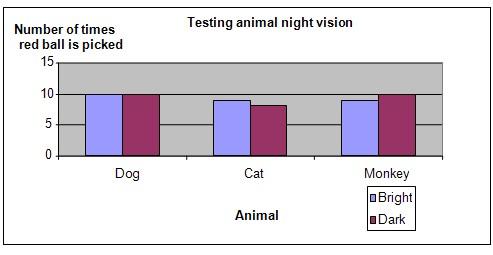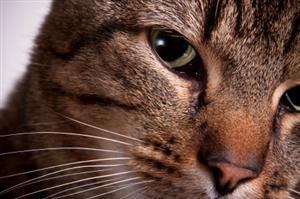| Complexity level: | 6 |
| Project cost ($): | 20 |
| Time required: | 14 days to prepare, 1 day for observation |
| Material availability: | You will need access to domesticated, trained animals. The dog and cat won't be a problem, but the monkey will take some effort to locate. Try asking your local zoo to help |
| Safety concerns: | Treat animals with respect and care - and ensure that they are handled by qualified trainers at all times. Although they may be domesticated, the animals may bite if unexpectedly provoked or agitated |
Hypothesis
Dogs, cats and monkeys are all able to see color in the dark.
Overview
Animals and night vision
Night vision refers to the ability to see in a dark or extremely low-light environment. Humans have very poor or limited night vision. When we wake up in the middle of the night to go to the bathroom, we struggle to find the light switch. However, as our eyes gradually adjust to the darkness, we develop limited night vision.
Some animals however, have excellent night vision. Nocturnal animals which are active in the night and sleep in the day, have an evolved and more advanced sense of hearing, smell and sight so that they can effectively find food, hunt and avoid their predators in the dark. The eyes of nocturnal animals have light sensitive receptor cells, called rods, that can be up to 500 times more sensitive than normal receptors (called cones).
Nocturnal animals with improved night vision usually have eyes that are larger (compared to their bodies). These larger eyes enable them to dilate their pupils so that more light enters the eyes, and in so doing enables the animal to have better night vision.
Some nocturnal animals also have eyes that have a reflective membrane called the tapetum lucidum . This membrane helps to conserve light within the eye by reflecting it on the retina before it escapes out of the eye. This allows these animals to have augmented vision in the dark. The shine or glow in the eyes of these animals, such as cats, dogs and deer when light hits their eyes in the dark, is a result of the tapetum lucidum.
Other animals differ in how they are able to effectively see in the dark. Some have folded retinas and others have special lenses.
Scientific Terms
Materials
The materials required for this science fair project:
- A monkey
- A dog
- A cat
- A box of pet snacks for the dog, cat and monkey
- A red, blue and yellow ball
- A dark room with no windows or a room with windows and curtains
- An animal trainer
Procedure
1. For this science fair project, the independent variable is the type of animal and the condition of the room – bright or dark. The dependent variable is the color of the ball selected by the animal. This is determined by observing the color of the ball selected by the animal. The constants (control variables) are the period of training, the size of the ball, the color of the ball and the size of the room.
2. The experiment is done with a dog, a cat and a monkey. The 3 animals are trained for 14 days with the help of an animal trainer. The animal trainer will train the animals to select only the red color ball from amongst the other colored balls. Every time the animal selects the red ball, it is given a treat and pat as rewards to reinforce this behavior.
3. After 2 weeks of training, a dark room is prepared for the experiment. The dog, cat and monkey will be tested separately. Each animal is tested 10 times in a bright environment. To ensure accuracy, have all the balls wiped clean, and have them randomly placed (do not place them in the same position each time). The number of times they successfully selected the red ball is recorded in the table given below.
4. Next, the window’s curtains are drawn (if required) and all the lights are switched off. The room should be in total darkness. Each animal is required to select the red ball in the dark environment. The number of times each animal successfully selects the red ball is recorded in the table below. Again, to ensure accuracy, have all the balls wiped clean, and have them randomly placed (do not place them in the same position each time).

Results
It is observed that in the dark environment, the dog, cat and monkey were able to successfully select the red color ball most of the time.
| Room | Number of times the red ball was selected | ||
| Dog | Cat | Monkey | |
| Bright | 10 | 9 | 9 |
| Dark | 10 | 8 | 10 |
The graph below represents the results of our science experiment

Conclusion
The hypothesis that dogs, cats and monkeys are able to see color in the dark. is proven to be correct.
Whilst most humans are asleep at night, nocturnal animals are active and emerge from their habitats to hunt for food. These nocturnal animals have a highly evolved sense of smell, hearing and night vision . Nocturnal birds like the owl have telescopic vision and the fruit bats use sonar for navigation and for finding food in the dark. Some animals are a little more unique. The cat, for example, is able to see effectively both in bright and dark environments.
Also consider
What would happen if this science fair project were to be repeated using other animals such as rats, hamsters or squirrels?
Try to repeat the experiment using various breeds of dogs, cats and monkeys.
Would your results differ if you were to restrict the animals' ability to smell by for example, introducing a strong, over-powering scent into the room?
References
Nocturnality - http://en.wikipedia.org/wiki/Nocturnality
Night vision - http://www.teachersdomain.org/resource/tdc02.sci.life.reg.nightvis/
Night vision optics- human versus animal - http://ezinearticles.com/?Night-Vision-Optics---Human-Versus-Animal&id=2542616

